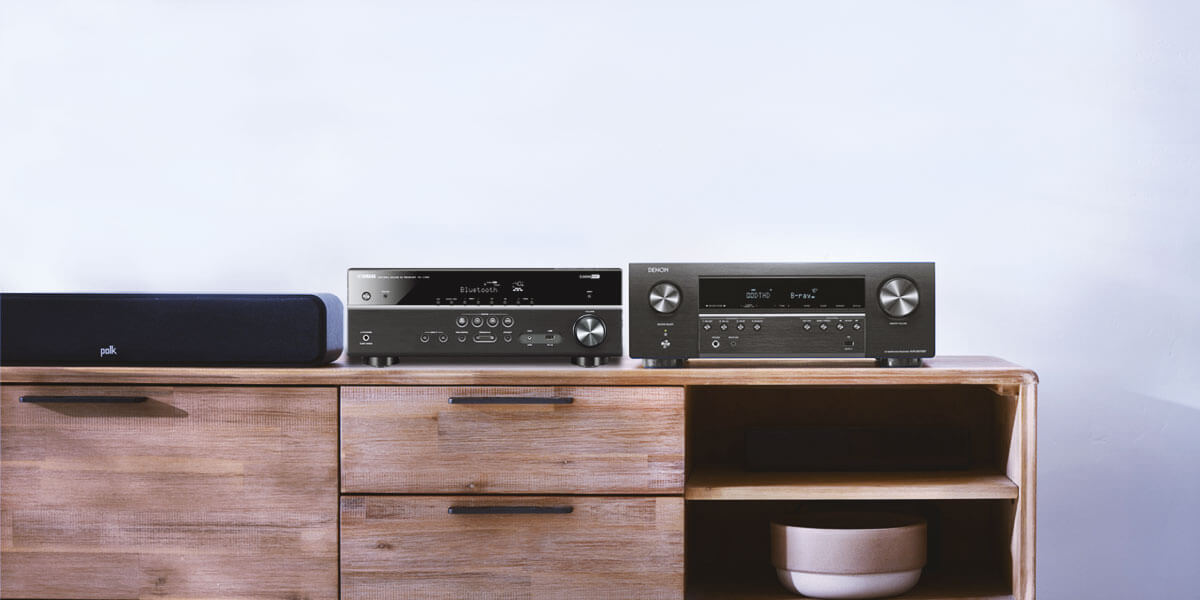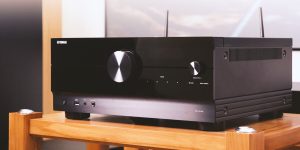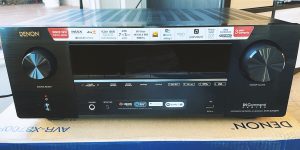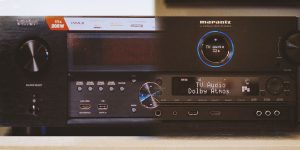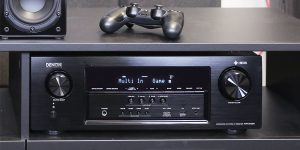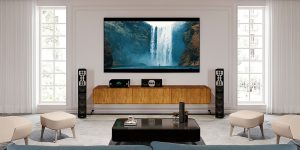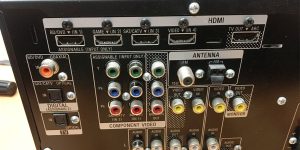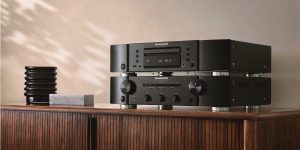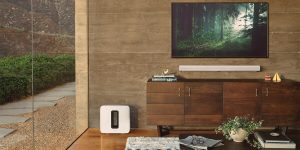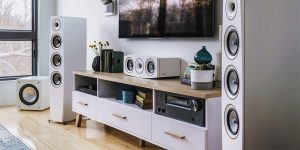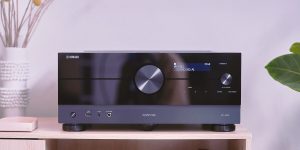In search of a quality receiver that will turn your home theater or sound system into something out of this world, you will probably encounter two brands that have established leading positions on the market. Up to these days, there are heated Denon vs Yamaha debates about which receivers deliver better performance and sound.
Both companies started their journey by being inspired by creative passion and technical brilliance. Throughout years of innovation, Yamaha and Denon have built a strong legacy of receivers that went ahead of time and introduced new technologies for exceptional home entertainment.
Both Yamaha and Denon offer receivers for different tastes and budgets. Whether you are just entering the realm of Hi-Fi sound or want to extend the capabilities of your sound system with a robust receiver, these companies will have something special for you. So, in this review, I have put together products from various categories to decide which model delivers a better audio experience.
Denon vs Yamaha AV receivers
Undoubtedly, as we compare Yamaha vs Denon receivers, it’s hard to say right away which brand outperforms another. There are definitely stellar models and ones that may have some space for improvement in both companies. Therefore, comparing specific products within a certain category will make sense.
But in more general terms, Yamaha receivers tend to be on the pricier side. However, many users report, and I totally agree with them, that these devices have a higher quality of the receivers’ build. At the same time, Denon receivers are a golden middle between the price and quality. They are more affordable than Yamaha receivers but offer nearly the same capabilities.
Premium receivers comparison
Yamaha RX-A6A vs Denon AVR-X4700H
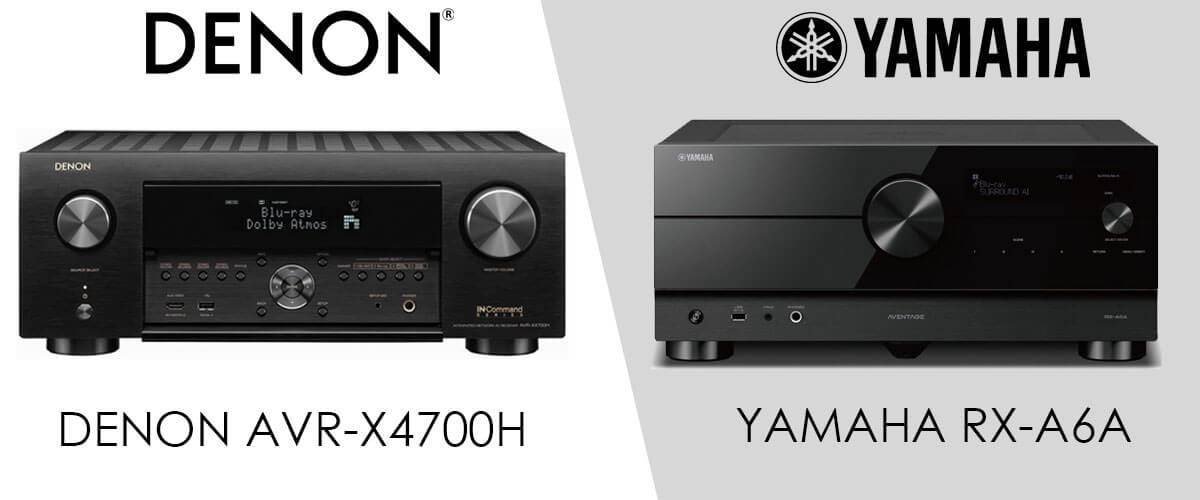
| Model | Yamaha RX-A6A | Denon AVR-X4700H |
| Channels | 9.2 | 9.2 |
| Power output | 150W/8 ohm | 125W/8 ohm, 165W/6 ohm |
| Sound features | DTS HD Master, DTS:X, Dolby TrueHD, Dolby Atmos, Atmos Height Virtualization, Dolby Surround, Auro 3D, Cinema DSP | DTS HD Master, DTS:X, DTS Neural:X, Dolby TrueHD, Dolby Atmos, Atmos Height Virtualization, Dolby Surround, Auro 3D, Audyssey |
| Multichannel Pre Out | Yes (9.2) | Yes (11.2) |
| HDMI inputs/outputs | 8/3, 8K/60Hz, 4K/120Hz pass-through, upscales video signals to HD and Ultra HD (up to 8K) | 7/3, 8K/60Hz, 4K/120Hz pass-through, upscales video signals to HD and Ultra HD (up to 8K) |
| Video Features | Dolby Vision, HDR 10+, HDMI ARC, HDMI eARC, HDMI CEC | HDMI ARC, HDMI eARC, HDMI CEC, 3D Signal Pass-through |
| Video Conversion Analog to HDMI | yes | yes |
| Analog to HDMI Scaling | 480i/576i up to 8K 60/50 | 480i/576i up to 8K 60/50 |
If you can’t decide on the Denon or Yamaha receiver from the premium segment, here is a breakdown of the most popular products – Yamaha RX-A6A and Denon AVR-X4700H. Both have fascinating capabilities that let you hear the slightest whisper and see every detail.
These receivers support multichannel surround technologies like Dolby Atmos, DTS:X, and more for an immersive sound experience. Mind that Yamaha defaults its own proprietary 3D sound, which may prevent Dolby Atmos decoding. Nevertheless, its sound is crisp and clear without any distortions from the range of a whisper-quiet listening to entirely too loud. In respect of the sound quality, I like Yamaha RX-A6A more. I noticed that Denon AVR-X4700H distorts when the mid-range and bass get fairly full. Perhaps, this receiver just can’t handle it. But, truth be told, the Audyssey room correction does a good job on this device. It makes the sound more engaging, the bass tighter, and the mid-bass more vibrant.
To my taste, the configuration options and scene memories are more appealing in Yamaha RX-A6A. I find the default settings in Denon AVR-X4700H useless. I had to mess up with the receiver for many hours to find a setting that would satisfy my sound reproduction preferences. But it was worth it – this receiver opened up my speakers to a new level.
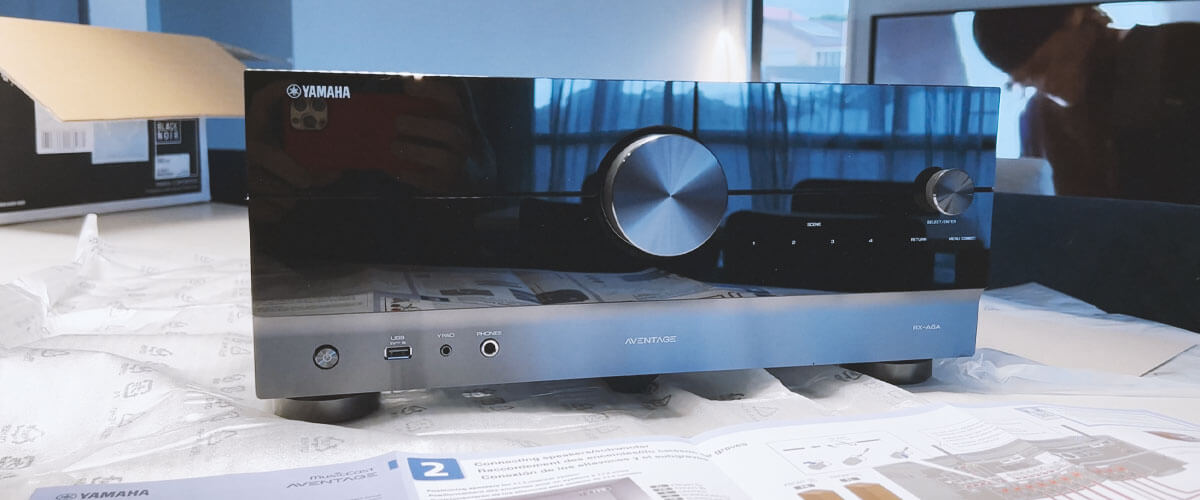
Both Yamaha RX-A6A and Denon AVR-X4700H are 9.2-channel receivers with 11.2-channel processing. Note that you will need an external amp to power the additional channels. So, literally, you can use nine speakers and two subwoofers with both models.
It’s good to know that two receiver models are 4K- and 8K- ready. They will enable you to assemble an exceptional home theatre system for smooth and sharp content viewing. The AVR-X4700H features an advanced HDMI section (8 in/3 out) with a dedicated 8K input that supports 8K/60Hz and 4K/120Hz video passthrough and upscaling. It provides VRR, ALLM, Dynamic HDR, HDR10+, and eARC support. In turn, Yamaha RX-A6A boasts 4K/120Hz and 8K/60Hz HDMI and HDR10+ with HDCP 2.3 and eARC (7 in/3 out).
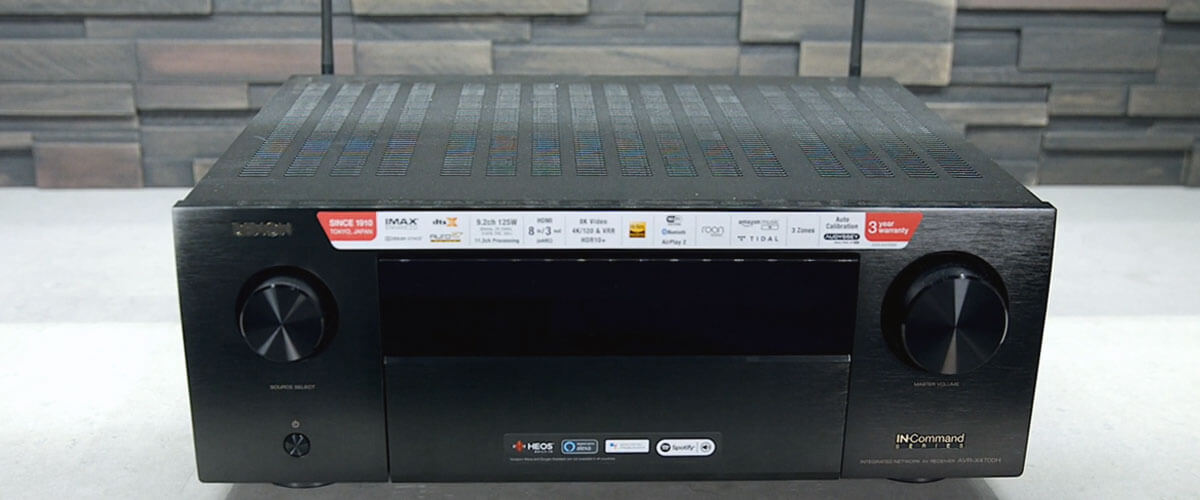
Such features as Wi-Fi, Bluetooth, MusicCast, AirPlay, and streaming of Spotify, Yamaha RX-A6A, and Denon AVR-X4700H have the same capabilities. Also, I like that you can control them hands-free with any of the voice control assistants like Amazon Alexa, Siri, and Google Assistant.
The choice of Yamaha RX-A6A and Denon AVR-X4700H receivers is a matter of taste. They are really top models with great features from which it is very difficult to single out a clear favorite.
Yamaha RX-A6A
Denon AVR-X4700H
Mid-priced receivers comparison
Yamaha RX-A2A vs Denon AVR-X1700H
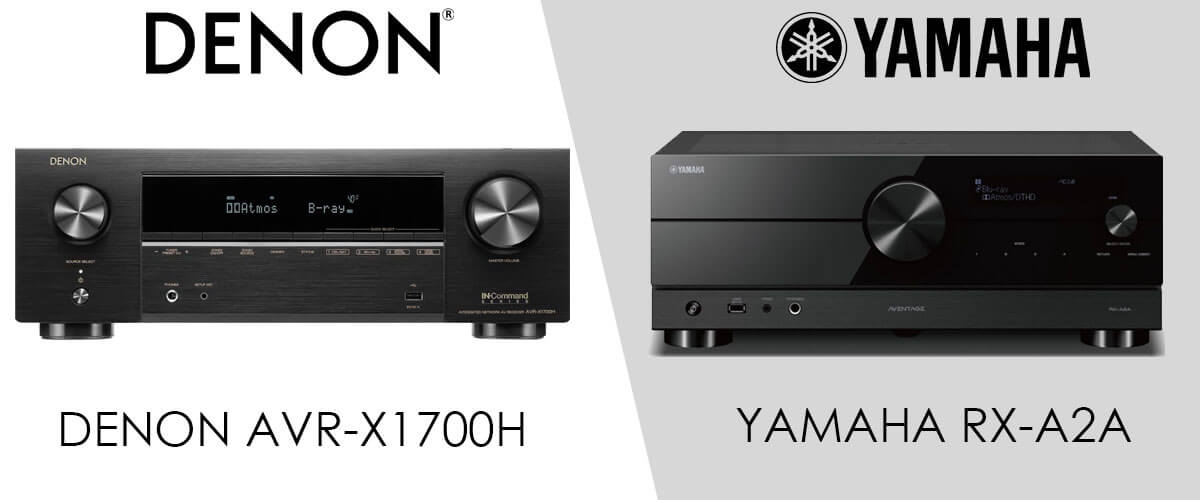
| Model | Yamaha RX-A2A | Denon AVR-X1700H |
| Channels | 7.2 | 7.2 |
| Power output | 100W/8 ohm | 80W/8 ohm, 120W/6 ohm |
| Sound features | DTS HD Master, DTS:X, Dolby TrueHD, Dolby Atmos, Atmos Height Virtualization, Dolby Surround, Cinema DSP | DTS HD Master, DTS:X, DTS Neural:X, DTS Virtual:X, Dolby TrueHD, Dolby Atmos, Atmos Height Virtualization, Dolby Surround, Audyssey |
| Multichannel Pre Out | Yes (7.1) | Yes (7.1) |
| HDMI inputs/outputs | 6/1, 8K/60Hz, 4K/120Hz pass-through, upscales video signals to HD and Ultra HD (up to 4K) | 7/1, 8K/60Hz, 4K/120Hz pass-through, upscales video signals to HD and Ultra HD (up to 8K) |
| Video Features | Dolby Vision, HDR 10+, HDMI ARC, HDMI eARC, HDMI CEC | Dolby Vision, HDR 10+, HDMI ARC, HDMI eARC, HDMI CEC, HLG |
| Video Conversion Analog to HDMI | no | no |
| Analog to HDMI Scaling | no | no |
So, it’s time to compare Denon AVR-X1700H DAB and Yamaha Aventage RX-A2A to reveal the strong and weak sides of these receivers before you make the final decision about which model to buy.
Let me start the comparison of Denon vs Yamaha with the sound quality. Of course, each brand has its own unique sound and its own special features, but to say that one sounds better than the other would not be correct.
Yamaha RX-A2A delivers amazing stereo imaging and placement of instruments. The overall soundstage is well-defined, and the detail retrieval is impressive. But I have a few complaints. As I was reproducing some music via YouTube, I was not satisfied with the audio delays. There were some serious lags, which made listening to my favorite tracks painful. Also, I purchased this receiver to match my MusicCast surround speakers. What a disappointment it was to figure out that the connection with wireless speakers was unreliable. The connection dropped constantly, and I had to reinstall them several times a week.
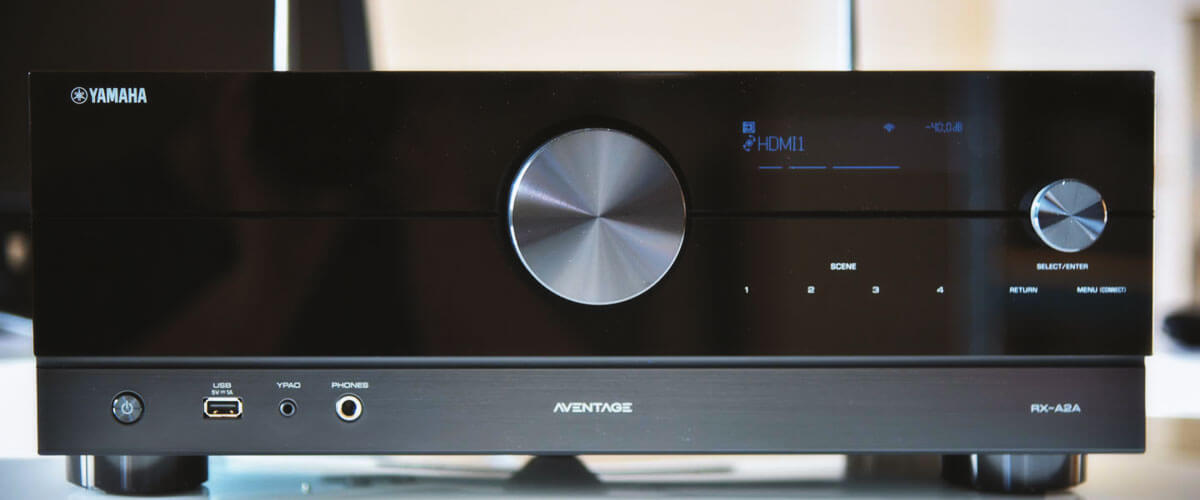
You can connect these receivers using Wi-Fi, Bluetooth, or an Ethernet cable. Denon AVR-X1700H doesn’t drop Wi-Fi and Bluetooth, which is good. But mind that it supports AirPlay 2, DLNA, and HEOS without an option to use Music Cast. Denon doesn’t compromise sound quality in this receiver, delivering a clean, stable, nicely steered, and detailed sound. It creates a soundstage with adequate scale and handles peak trebles perfectly.
Nevertheless, I find Denon AVR-X1700H less powerful as it delivers 80W of power output per channel, while Yamaha RX-A2A boasts 100W at the same 8 Ohms. You probably won’t feel the difference, but I must inform you about it. Both can decode Dolby Atmos and DTS:X, while Denon AVR-X1700H is also compatible with Dolby TrueHD and DTS-HD Master Audio.
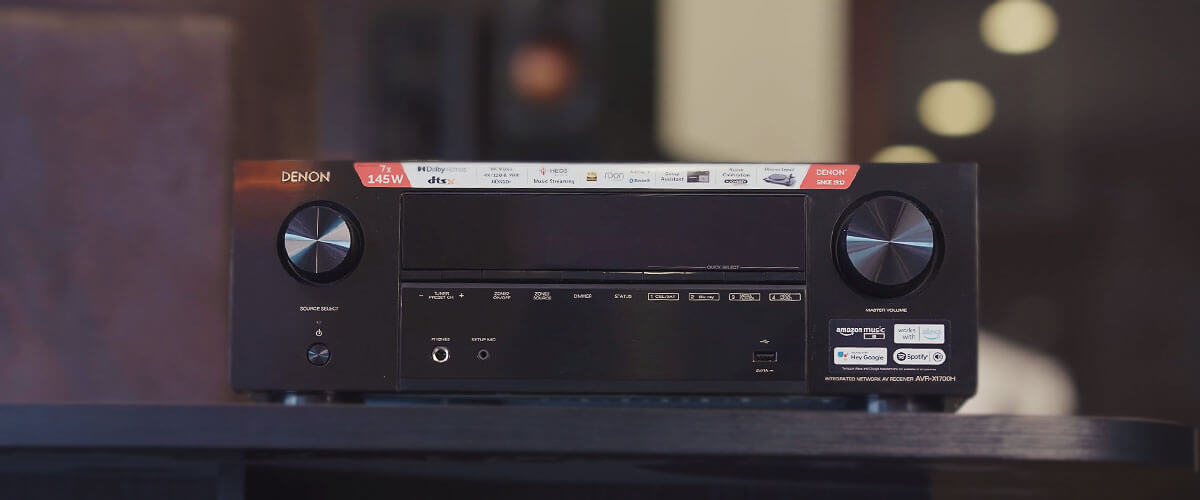
Both receivers support 8K passthrough up to 60p. Denon AVR-X1700H can do 8K upscaling up to 60p, while Yamaha Aventage RX-A2A can do 4K upscaling up to 60p. They also show compatibility with HDR10, HDR10+, Dolby Vision, and Hybrid Log Gamma.
Denon AVR-X1700H has 6 HDMI inputs with HDCP 2.3 copy protection, while Yamaha has one extra HDMI input (7 in total). Both work great with voice control systems and AirPlay 2.
When you want to focus on video reproduction, Denon AVR-X1700H will give you more freedom and satisfaction. Yamaha RX-A2A is nearly as good as Denon but may disappoint you with an unstable wireless connection.
Yamaha RX-A2A
Denon AVR-X1700H
Denon AVR-X2700H vs Yamaha RX-A4A
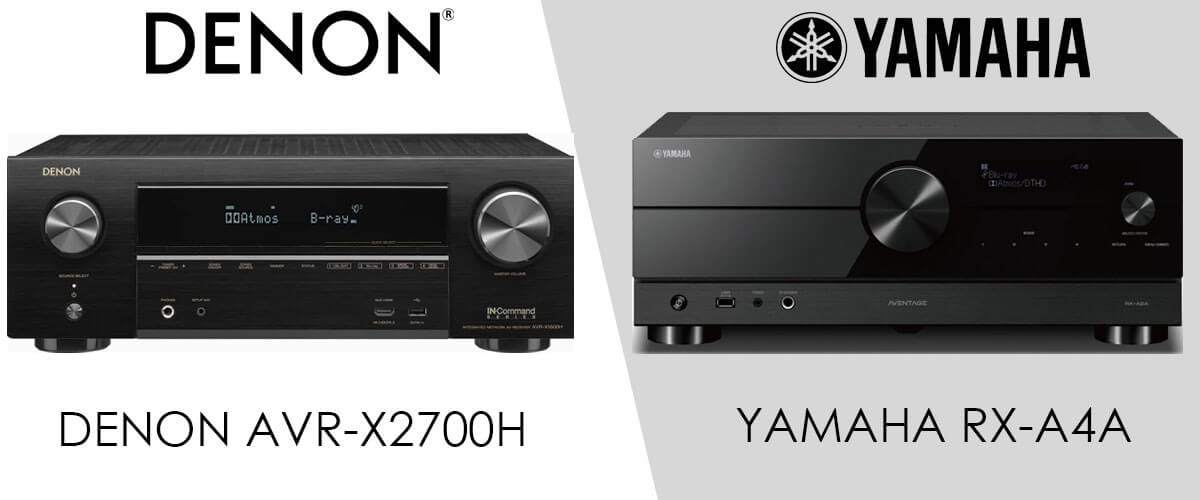
| Model | Yamaha RX-A4A | Denon AVR-X2700H |
| Channels | 7.2 | 7.2 |
| Power output | 110W/8 ohm | 95W/8 ohm, 125W/6 ohm |
| Sound features | DTS HD Master, DTS:X, Dolby TrueHD, Dolby Atmos, Atmos Height Virtualization, Dolby Surround, Cinema DSP | DTS HD Master, DTS:X, DTS Neural:X, Dolby TrueHD, Dolby Atmos, Atmos Height Virtualization, Dolby Surround, Audyssey |
| Multichannel Pre Out | Yes (7.1) | Yes (7.1) |
| HDMI inputs/outputs | 6/1, 8K/60Hz, 4K/120Hz pass-through, upscales video signals to HD and Ultra HD (up to 8K) | 7/1, 8K/60Hz, 4K/120Hz pass-through, upscales video signals to HD and Ultra HD (up to 8K) |
| Video Features | Dolby Vision, HDR 10+, HDMI ARC, HDMI eARC, HDMI CEC | Dolby Vision, HDR 10+, HDMI ARC, HDMI eARC, HDMI CEC, HLG |
| Video Conversion Analog to HDMI | no | no |
| Analog to HDMI Scaling | no | no |
As both Denon AVR-X2700H and Yamaha RX-A4A belong to the mid-priced segment of receivers, it makes sense to compare them to see which one will better meet your needs.
The choice of Denon AVR-X2700H or Yamaha RX-A4A based on the sound is an individual thing. Yamaha has more weight due to more explicit bass, while Denon delivers detailed yet thinner sounding.
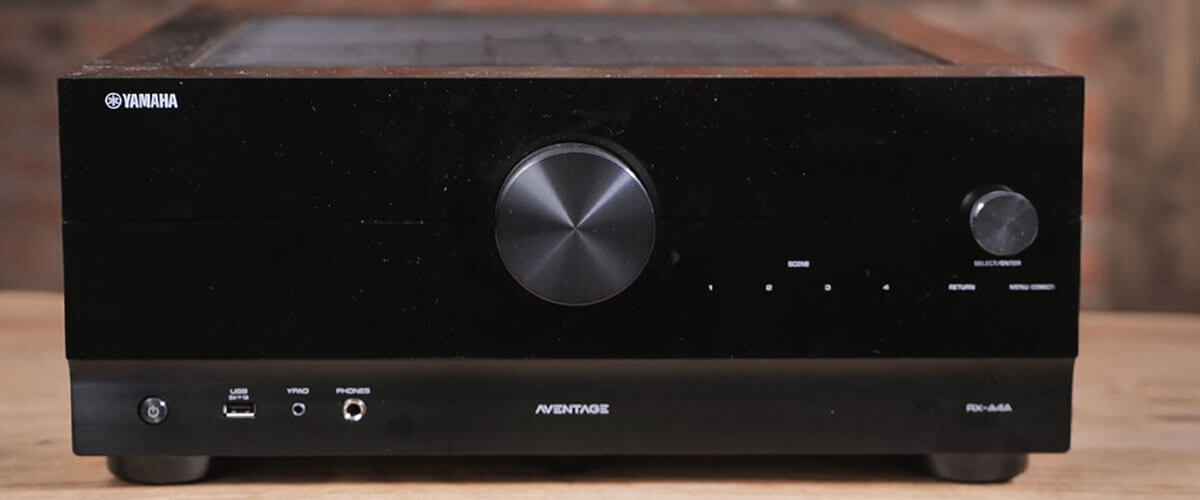
Both devices support up to 7 channels. Also, the units support a 5.2.2 channels configuration. As usual, they have support for Dolby Atmos as well as DTS:X, so they are compatible with multichannel surround sound formats. Additionally, the reviewed models of Denon and Yamaha have great up-mixing technologies that convert legacy tracks into surround audio.
Denon AVR-X2700H has Audyssey MultEQ calibration technology that delivers a smooth listening experience to all people in the room. For me, the Denon AVR-X2700H is better than the Yamaha RX-A4A, thanks to this feature. But Yamaha has its own exclusive characteristic – Cinema DSP HD3. It gives a sound field an extra vertical dimension, using multiple CINEMA DSP engines that losslessly decode 192kHz signals. Thus, it is capable of recreating different audio spaces like concert halls or arenas, which gave me a high level of immersion while I tested this receiver.
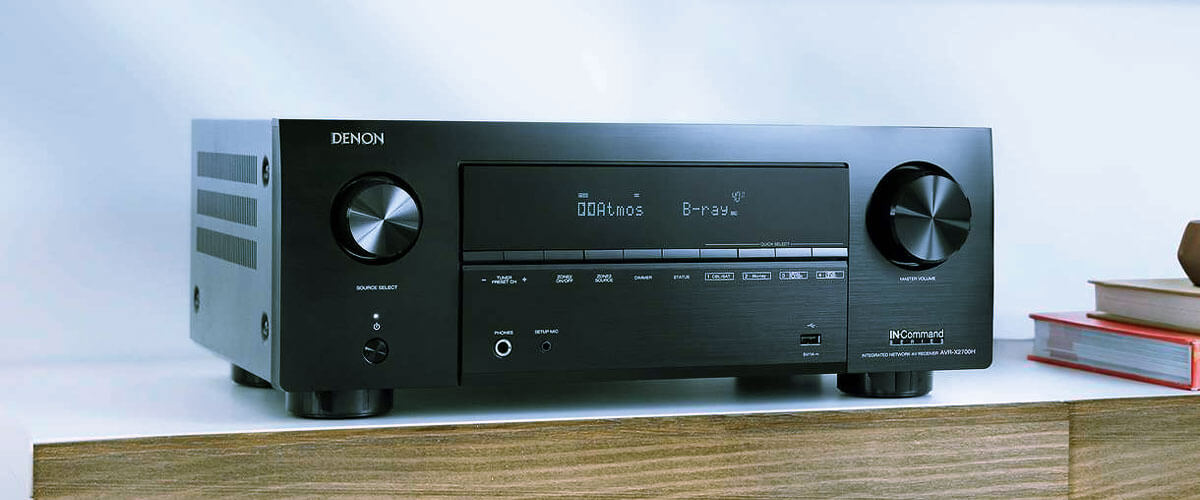
In terms of connectivity, these receivers are pretty much the same. Their Wi-Fi modules have the same characteristics – 2.4/5GHz. Both rivals support Bluetooth, are compatible with AirPlay, and can stream Amazon Music, Spotify, Deezer, TIDAL, Pandora, and SiriusXM. The AVR-X2700H can also work with the audio stream from Qobuz, TuneIn Radio, while its competitor with Napster, SoundCloud.
The compared receivers retain the quality of 4K/120Hz and 8K/60Hz HDMI signals. Both units support HDR and HDR10+ standards, allowing for more realistic image reproduction. In addition, the Yamaha RX-A4A has 7/3 HDMI input/output connectors versus 6/2 HDMI inputs/outputs of the Denon AVR-X2700H, allowing it to connect slightly more devices.
I do not see much difference in the performance of these two receivers, even though Yamaha RX-A4A has a more robust build and a sleeker look, while Denon AVR-X2700H may attract you with a lower price tag.
Yamaha RX-A4A
Denon AVR-X2700H
Entry-level receivers comparison
Yamaha RX-V385 vs Denon AVR-S570BT
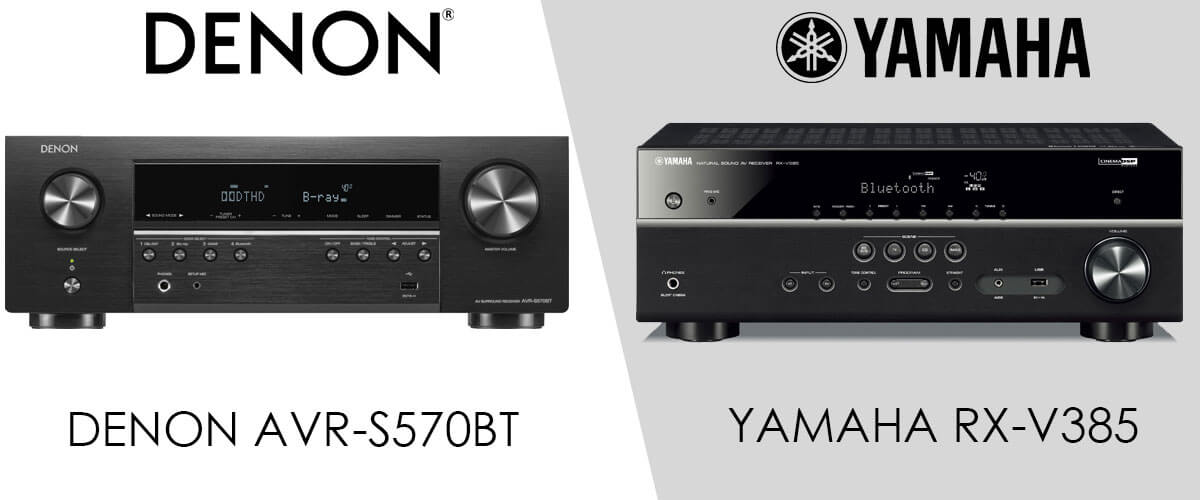
| Model | Yamaha RX-V385 | Denon AVR-S570BT |
| Channels | 5.1 | 5.2 |
| Power output | 70W/8 ohm | 70W/8 ohm, 90W/6 ohm |
| Sound features | DTS HD Master, Dolby TrueHD, Dolby Digital Plus, Cinema DSP | DTS HD Master, Dolby TrueHD, Audyssey |
| Multichannel Pre Out | Yes (5.1) | Yes (5.1) |
| HDMI inputs/outputs | 4/1, 4K/60Hz pass-through, upscales video signals to HD and Ultra HD (up to 8K) | 4/1, 8K/60Hz, 4K/120Hz pass-through, upscales video signals to HD and Ultra HD (up to 8K) |
| Video Features | HDMI ARC, HDMI eARC, HDMI CEC, HDMI 3D Pass-through | Dolby Vision, HDR 10+, HDMI ARC, HDMI eARC, HDMI CEC, HLG |
| Video Conversion Analog to HDMI | no | no |
| Analog to HDMI Scaling | no | no |
Newcomers looking for low-cost receivers in the world of Hi-Fi sound should not pass by Yamaha RX-V385 and Denon AVR-S570BT. These receivers offer nearly the same capabilities, so let’s see how each performs.
First, I want to rivet your attention to the fact that you should not expect advanced audio features in these low-budget receivers. Nevertheless, these AVRs are perfect for ordinary usage, allowing to run five speakers and a subwoofer, which is more than enough for a person to start exploring the Hi-Fi sound world.
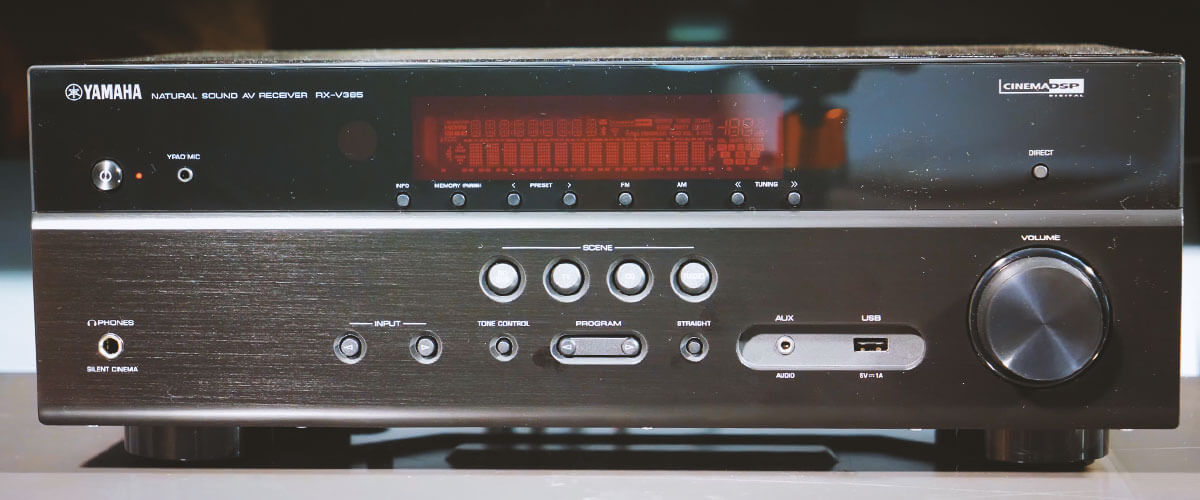
Yamaha RX-V385 will not surprise you with the quality sound out of the box. As I set up the YPAO, the sound was neither good nor loud. In addition, the subwoofer didn’t put out the bass in sync with the speakers, and the bass was muddy low. Considering that the instructions in the manual were not very informative, I had to spend nearly the whole day setting up the receiver. Luckily, the on-screen setup was helpful, and there were plenty of tutorials on YouTube and Reddit. But once you figure out how to get this unit running correctly, you will love it. After proper configuration, I obtained the desired audio quality – a clean and weighty sound.
I would say that the Denon AVR-S570BT is a better choice for starters due to the ease of setup. It took me a few minutes to configure the receiver to extract an excellent level of performance from it. This model of the Denon receiver handles movie and music sounds at low and high volumes flawlessly. I like the automatic calibration, which customizes the sound output based on your seated location, the speakers’ output, and room acoustics.
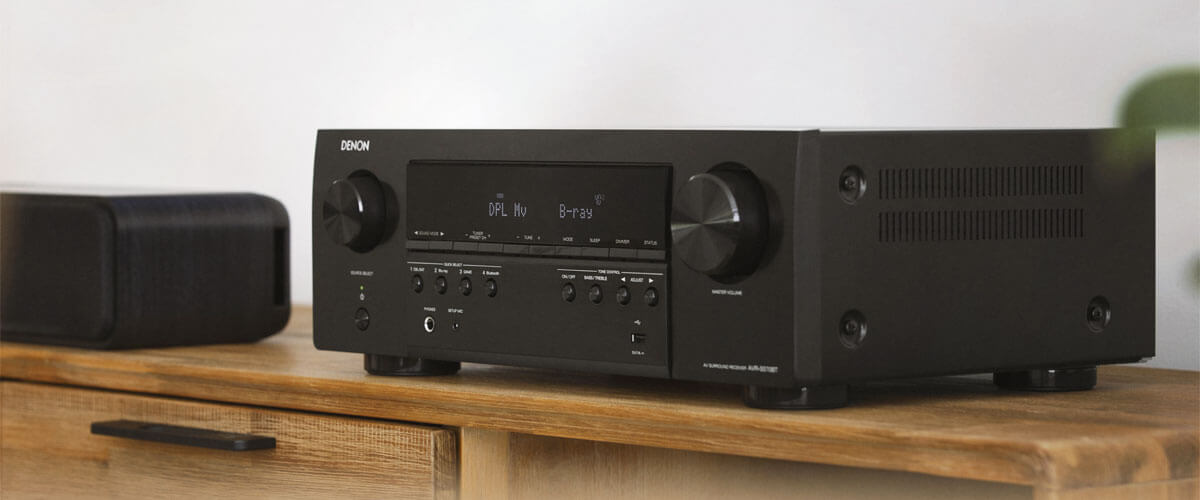
Yamaha RX-V385 supports 4K Ultra HD, HDR10, Dolby Vision, Hybrid Log-Gamma, and BT.2020. Its rival, Denon AVR-S570BT, went further and is compatible with 8K/60Hz, 4K/120Hz, HLG, HDR, Dolby Vision, HDR10+ passthrough, and 8K upscaling on all four HDMI inputs and one output.
Regarding connectivity, Yamaha RX-V385 and Denon AVR-S570BT do not support Wi-Fi and voice control. But you can use a Bluetooth connection to enjoy your audio content wirelessly.
As a newer model, Denon AVR-S570BT may offer more features and deliver better video streaming than Yamaha RX-V385. Considering the same price, I will give my voice to the Denon model in this battle of entry-level receivers.
Yamaha RX-V385
Denon AVR-S570BT
